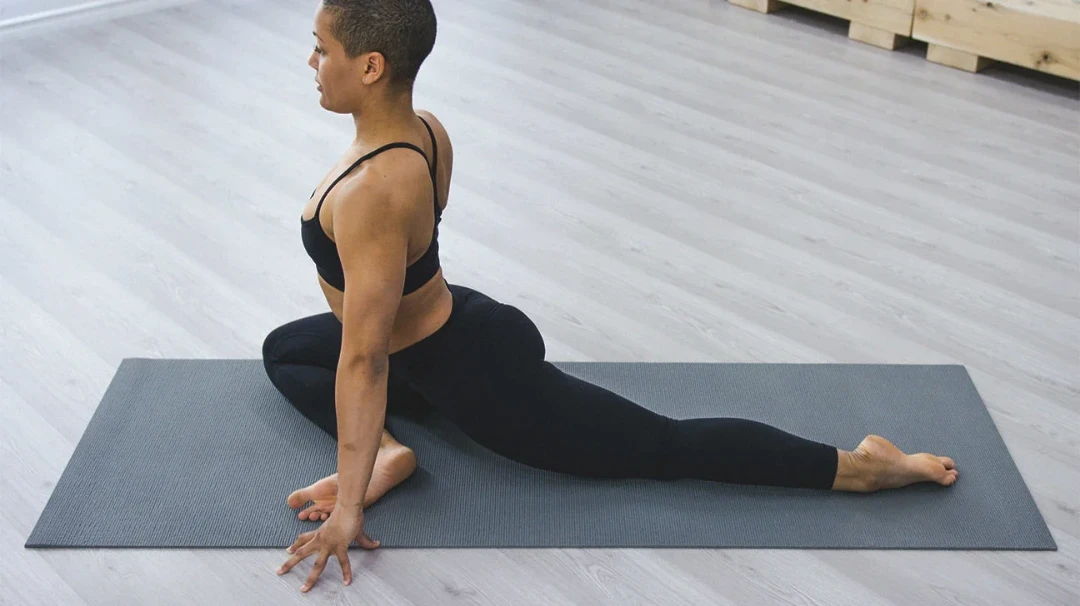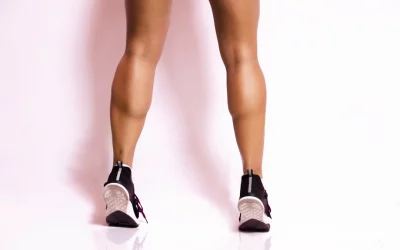Sciatica and piriformis syndrome—now there’s a duo that can really cramp your style. It’s that deep, nagging discomfort that shoots down your leg, making even simple things like sitting or standing up feel like a major effort. The culprit? Often, it’s a tight piriformis muscle pressing on your sciatic nerve, turning your day into a real pain.
But here’s the good news: targeted stretching can help! By loosening up the piriformis muscle, you can relieve that sciatic pain and get back to moving comfortably. In this article, we’re covering the best deep stretches for sciatica relief, from the relaxing Supine Piriformis Stretch to the powerful Pigeon Pose. So, grab your mat and get ready to stretch those troubles away—because who needs sciatic pain cramping your style?
Understanding Piriformis Syndrome and Sciatica
The piriformis muscle, a small, pear-shaped muscle located deep in the buttock, plays a crucial role in hip rotation and stabilization. But when this muscle gets too tight, it can press against the sciatic nerve—which runs down from the lower back through the legs—causing the familiar, uncomfortable sensation known as sciatica.
Piriformis syndrome often develops due to daily habits like prolonged sitting, poor posture, or even overuse from activities like running. When the piriformis muscle becomes tense, it can press directly on the sciatic nerve, leading to symptoms like tingling, numbness, or sharp pain radiating down the leg.
“Sometimes, a little attention to that stubborn piriformis muscle is all it takes to bring real relief. Give it a proper stretch, and you might be surprised at how much tension releases, letting that sciatic pain start to ease away.”
Essential Deep Piriformis Stretches for Sciatic Pain Relief
Seated Piriformis Stretch
The Seated Piriformis Stretch is a powerful yet simple exercise that helps release tension in the piriformis muscle, making it ideal for alleviating sciatic pain. This stretch effectively targets the deep hip area, easing pressure on the sciatic nerve and promoting relaxation in the lower body.
This stretch is especially beneficial as it helps:
-
Release sciatic nerve pressure by loosening the piriformis.
-
Boost hip flexibility for easier daily movement.
-
Relieve lower back and glute tension for added comfort.
To perform the Seated Piriformis Stretch, follow these steps:
-
Sit on the floor with your legs extended in front of you.
-
Cross your right ankle over your left knee, placing your foot on the floor.
-
Lean forward slightly, keeping your back straight, until you feel a stretch in your right hip.
-
Hold for up to 30 seconds, breathing deeply, then switch sides.
Supine Piriformis Stretch
The Supine Piriformis Stretch provides a deep, relieving stretch for the piriformis muscle by gently releasing tightness. This stretch is perfect for easing sciatic pain without placing strain on the lower back.
This stretch is particularly beneficial as it helps:
-
Release the piriformis, alleviating sciatic nerve irritation.
-
Improve flexibility in the hip area.
-
Relieve discomfort in the lower back and upper leg.
To perform the Supine Piriformis Stretch, follow these steps:
-
Lie on your back with both knees bent.
-
Cross your right ankle over your left knee.
-
Grasp the back of your left thigh and gently pull your legs toward your chest.
-
Hold for up to 30 seconds, then switch sides.
Pigeon Pose
The Pigeon Pose is a deep hip opener that stretches the piriformis and surrounding muscles, helping to relieve sciatic pain and increase flexibility in the hips. This yoga-inspired pose offers an intense stretch and is ideal for those seeking relief in the lower body.
This stretch is particularly beneficial as it helps:
-
Release tension in the piriformis and hip muscles.
-
Enhance flexibility in the hips and lower back.
-
Improve overall hip alignment and comfort.
To perform the Pigeon Pose, follow these steps:
-
Begin in a tabletop position on your hands and knees.
-
Bring your right knee forward, placing it behind your right wrist.
-
Extend your left leg straight behind you, keeping your hips square to the ground.
-
Hold for up to 30 seconds, then switch sides.
Figure 4 Stretch
The Figure 4 Stretch is a versatile exercise that can be done either seated or lying down, making it accessible for all levels. This stretch gently targets the piriformis and surrounding hip muscles, providing relief for sciatic pain.
This stretch is especially beneficial as it helps:
-
Relieve tension in the lower back and piriformis.
-
Improve flexibility and mobility in the hips.
-
Ease sciatic discomfort with gentle, effective stretching.
To perform the Figure 4 Stretch, follow these steps:
-
Lie on your back with both knees bent.
-
Cross your right ankle over your left thigh, forming a “4” shape.
-
Grasp the back of your left thigh and pull your legs toward your chest.
-
Hold for up to 30 seconds, then switch sides.
Incorporating these essential piriformis stretches into your daily routine can provide lasting relief, improve flexibility, and reduce sciatic pain over time. To make these exercises even more effective, explore tailored routines from WeStretch, where Ada and Bruce can guide you in building the perfect stretching plan for your needs.
Incorporating Piriformis Stretches into Daily Life for Pain Management
Building a routine around piriformis stretches can be incredibly effective for managing sciatica and keeping pain at bay. Integrating these stretches into your day doesn’t need to be complicated—it can actually fit right into your morning and evening habits. Here are some practical tips to get you started on a path to consistent relief.
Begin your day with gentle stretches, like the Seated Piriformis Stretch, to wake up your hip muscles and set the tone for a comfortable day. In the evening, unwind with deeper stretches such as the Supine Piriformis Stretch or Pigeon Pose, which can help release any tension built up from sitting or other activities.
Consistency is key for lasting relief, and with WeStretch’s Pro features, maintaining a daily routine has never been easier. By making these stretches a habit, you can prevent piriformis tightness from irritating the sciatic nerve, reducing the risk of recurring pain. WeStretch lets you customize routines, track progress, and access unlimited, specialized stretches tailored to your needs—keeping you on track for improved flexibility, reduced discomfort, and greater ease of movement.
Exercise Smarter with WeStretch: Your All-in-One Stretching Assistant
A consistent full-body stretching routine is essential for improving flexibility, supporting injury prevention, and enhancing overall well-being. Carefully following simple yet effective stretches targeting the hamstrings, hip flexors, back, quads, chest, and shoulders, individuals of any fitness level can reap the benefits.
Regular stretching, with attention to proper form and consistency, can help you move more freely, recover faster, and feel better in everyday activities.
Looking for a way to add some fun to your stretching routine? Check out WeStretch—an app that’s like your own personal stretch coach! With tailored plans, easy-to-follow demos, and progress tracking, it’s got everything you need to keep you limber and on point. Ready to get flexible? Sign up today and let’s get stretching!
FAQ
What is the best piriformis stretch for relieving sciatic pain?
The best stretch depends on your comfort and flexibility level. The Supine Piriformis Stretch and Figure 4 Stretch are excellent options for beginners, offering a gentle yet effective release. These stretches directly target the piriformis muscle, helping to reduce sciatic nerve compression. Incorporate them regularly for optimal relief.
How often should I do piriformis stretches for sciatica relief?
To relieve sciatic pain, aim to do piriformis stretches at least 3-4 times per week. For consistent pain management, daily stretching is ideal. Regular practice improves flexibility, reduces piriformis tension, and prevents nerve compression, leading to long-term relief and comfort in daily movements.
Can tight piriformis muscles cause sciatic pain?
Yes, tightness in the piriformis muscle can irritate the nearby sciatic nerve, leading to pain, tingling, or numbness that radiates down the leg. Known as piriformis syndrome, this condition is a common cause of sciatic pain. Stretching helps relieve this tension, reducing nerve irritation and associated discomfort.
Are these piriformis stretches suitable for beginners?
Absolutely! These stretches are beginner-friendly and can be modified to suit your flexibility level. The Figure 4 Stretch and Seated Piriformis Stretch are accessible options that gently relieve tension in the hip and piriformis area. Start slowly, only stretching as far as you comfortably can, and progress over time.
How long should I hold each piriformis stretch?
For best results, hold each stretch for up to 30 seconds. This duration allows the muscle to release tension without overstretching. Be mindful of your body’s limits and breathe deeply throughout each stretch. Repeat on both sides to ensure balanced relief, and adjust as needed for comfort.






